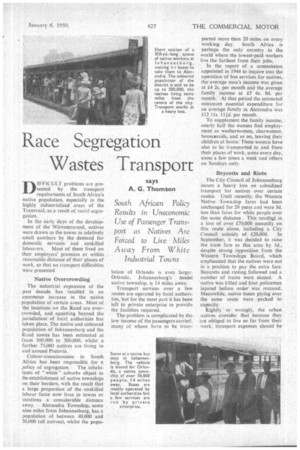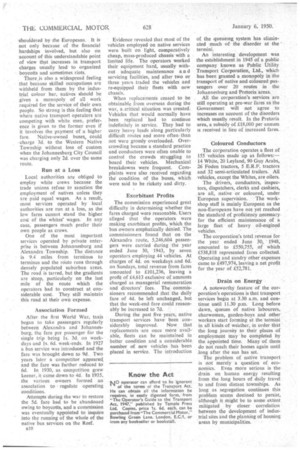Race Segregation Wastes Transport
Page 43

Page 44

If you've noticed an error in this article please click here to report it so we can fix it.
says A. G. Thomson
South African Policy Results in Uneconomic Use of Passenger Trans
. port as 'Natives Are Forced to Live Miles Away From White Industrial Towns
DIFFICULT problems are presented by the transport requirements of South Africa's native population, especially in the highly industrialized areas of the Transvaal, as a result of racial segre
gation. .
In the early days of the development of the Witwatersrand, natives were drawn to the towns in relatively small numbers by the demand for domestic servants and unskilled labourers. Most of them lived on their employers' premises or within reasonable distance of their places of work, so that no transport difficulties were presented Native Overcrowding The industrial expansion of the past decade has regulted in an enormous increase in the native population of certain areas. Most of the locations on the Rand are overcrowded, and squatting_ beyond the jurisdiction of local authorities has taken place. The native and coloured population of Johannesburg and the Rand towns has been estimated at from 300,000 to 500,000, whilst a further 75,000 natives are living in and 'around Pretoria.
Colour-consciousness in South Africa has been responsible for a policy of segregation. The inhabitants of "white" suburbs object to the establishment of native townships on their borders, with the result that a large proportion of the unskilled labour force now lives in towns or iocations a considerable distance away. Alexandra Township, some nine miles from JohanneSburg, has a population of between 40,000 and 50,000 (all natives), whilst the popu lation of Orlando is even larger. Orlando, Johannesburg's model native township, is 14 miles away.
Transport services over a few routes are operated by local authorities, but for the most part it has been left to private enterprise to provide the facilities required.
• The problem is complicated by the low income of the passengers carried, many of whom have to be trans ported more than 20 miles on every working day. South Africa is perhaps the only country in the world where the lowest-paid workers live the farthest from their jobs.
In the report of a commission appointed in 1944 to inquire into the operation of bus services for natives, the average man's income was given at £4 2s. per month and the average family income at £5 6s. M. per month. At that period the estimated minimum essential expenditure for an average family in Alexandra was £12 lls. llid. per month.
To supplement the family income, .nearly half the women find employment as washerwomen, charwomen, housemaids, and so on, leaving their children at home. These women have also to be transported to and from their places of work, some every day, some a few times a week and others on Sundays only.
Boycotts and Riots
The City Council of Johannesburg incurs a heavy loss on subsidized transport for natives over certain routes. Until recently, the Western Native Town3hip fares had been unchanged for 20 years and were 3d. less than fares for white people over the same distance. This resulted in a loss of over £70,000 annually on this route alone, including a City
Council subsidy of £20,000. In September, it was decided to raise the tram fare to this area by Id., despite strong opposition from the Western Townships Board, which emphasized that the natives were not in a position to pay the extra fare. Boycotts and rioting followed and a number of trams were stoned. A native was killed and four policemen injured before order was restored. Meanwhile, native buses plying over the same route were packed to capacity.
Rightly or wrongly, the urban natives consider that because they are obliged to live so far from their work. transport expenses should be
,shouldered by the Europeans. It is not only because of the financial hardships involved, but also on account of this understandable point of view that increases in transport charges usually lead • to organized boycotts and sometimes riots.
Thereis also a widespread feeling that because skilled occupations are withheld from them by the industrial colour bar, natives should be given a monopoly of all work required for the service of their own people, So strong is this feeling that where native transport operators are competing with white men, preference •is given to the former even if it involves the payment of a higher fare. Native-owned busea, could -charge 3d. to the Western Native Township without loss of custom when the Johannesburg City Council was charging only 2d. over the same route.
Run at a Loss
Local authorities are obliged to employ white crews because the trade unions refuse to sanction the employment of natives unless they are paid equal wages. As a result, most services operated by local authorities are run at a loss, as the low fares cannot stand the higher cost of the whites' wages. In any case, passengers much prefer their own people as crews.
One of the most important services operated by private enterprise is between Johannesburg and Alexandra Township. The distance is 9.4 miles from terininus to terminus and the route runs through densely populated suburban areas. The road is tarred, but the gradients are steep, particularly on the last mile of the route which the operators had to construct at considerable cost. They still maintain this road at their own expense.
Association Formed After the first World War, taxis began to take passengers regularly between Alexandra and Johannesburg, the fare per passenger for the single trip being Is. 3d. on weekdays and Is. 6d. week-ends. In 1927 a bus service was introduced and the fare was brought down to 9d. Two years later a competitor appeared, and the fare was further reduced to 6d. In 1930, as competition grew keener, it came down to 4d. In 1935, the various owners formed an association to regulate operating conditions.
Attempts during the war to restore the 5d. fare had to be abandoned owing to boycotts, and a commission was eventually appointed to inquire into the running of the whole of the native bus services on the Reef.
Evidence revealed that most of the vehicles employed on native services were built on light, comparatively cheap, mass-produced chassis with a limited life. The operators worked their equipment hard, usually without adequate maintenance a n d servicing facilities, and after two or three years traded the vehicles and re-equipped their fleets with new chassis.
When replacements ceased to be obtainable from overseas during the war, a critical situation was created. Vehicles that would normally have been replaced had to continue indefinitely in service. They had to carry heavy loads along particularly difficult routes and more often, than not were grossly overloaded. Overcrowding became a standard practice and conductors were often unable to control the crowds struggling to board their vehicles. Mechanical breakdowns were frequent. Complaints were also received regarding the condition of the buses, which were said to be rickety and dirty.
Exorbitant Profits The commission experienced great difficulty in determining whether the fares charged were reasonable. Users alleged that the operators were making exorbitant profits, which the bus owners emphatically denied. The commissioners found that on the Alexandra route, 5,246,604 passengers were carried during the year ended June 30, 1943, by seven operators employing 44 vehicles. At charges of 4d. on weekdays and 6d. on Sundays, total revenue from fares amounted to £101,236, leaving a profit of £4,613 exclusive of amounts charged as managerial remuneration and directors' fees. The commissioners recommended that the daily fare of 4d. be left unchanged, but that the week-end fare could reasonably be increased to 7d.
During the past five years, native transport services have been considerably improved. Now that replacements are once more available, fleets can be maintained in better condition and a considerable number of new vehicles has been placed in service. The introduction of the queueing, system has eliminated much of the disorder at the termini.
An interesting development was the establishment in 1945 of a public company known as Public Utility Transport Corporation, Ltd, which has been granted a monopoly in the transport of native and coloured passengers over 20 routes in the Johannesburg and Pretoria areas.
All the corporation's services are still operating at pre-war fares as the Government will not agree to increases on account of the disorders which usually result. In the Pretoria area, a subsidy of £18,000 per annum is received in lieu of increased fares.
Coloured Conductors
The corporation operates a fleet of 155 vehicles made up as follows:14 White, 20 Leyland, 90 Guy Arabs, 26 Foden tractors, 5 E.R.F. tractors and 32 semi-articulated trailers. All vehicles, except the Whites, are oilers.
The drivers, conductors, inspectors, dispatchers, clerks and cashiers, are all, native or coloured, under European supervision. The workshop staff is mainly European as the non-Europeans have not yet reached the standard of proficiency necessary for the efficient maintenance of a large fleet of heavy oil-engined vehicles.
The corporation's total revenue for the year ended June 30, 1948, amounted to £550,755, of which £538,818 represented fares collected. Operating and sundry other expenses came to £497,974, leaving a net profit for the year of £52,781.
Drain on Energy
A noteworthy feature of the corporation's operations is that transport services begin at 3.30 a.m. and continue until 11.30 p.m. Long before dawn, queues of native labourers, charwomen, garden-boys and other workers start forming at the termini in all kinds of weather, in order that the long journ'ey to their places of employment may be completed by the appointed time. Many of them do not reach their homes again until long after the sun has set.
The problem of native transport is not merely a question of economics. Even more serious is the drain on human energy resulting from the long hours of daily travel to and from distant townships. As long as segregation continues this problem seems destined to persist, although it Might be to some extent mitigated by closer correlation between the development of industrial sites and the planning of housing areas by municipalities.




























































































